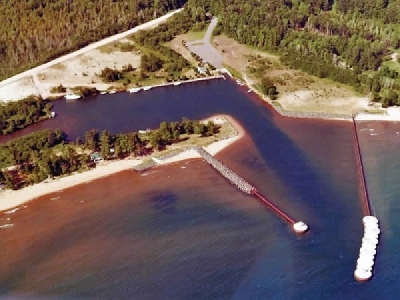
Posted on July 1, 2018
Dredging is expected to occur at the Big Bay Harbor of Refuge next spring, as the U.S. Army Corps of Engineers, Detroit District, has announced additions to its fiscal year 2018 program.
Within its recently approved work plan, $250,000 in funding has been allocated to dredge the harbor, which is located on Lake Superior, a half-mile north of Big Bay in Marquette County.
Eric Anderson, manager of planning for the Marquette County Planning, Community Development, Forestry and Recreation Department, said the additional Corps funding for the dredging project is “very good news.”
“Everyone concerned is grateful,” he said.
The Big Bay Harbor of Refuge was created in the 1960s as part of a statewide program to construct protective harbors and ensure vessels could be within 30 miles of a protective harbor at all times while traveling along Great Lakes coastline.
“It’s an important harbor for sport fishing, it’s also part of the harbor of refuge system, and so it’s the only harbor between Marquette and Keweenaw Bay on Lake Superior,” he said.
Dredging, which removes sediment and debris that has entered the harbor, helps maintain an appropriate harbor depth for vessels.
“It’s something that has to be done every few years. With the waves off Lake Superior, they move sediment (into the harbor),” Anderson said.
Dave Wright, chief of operations at U.S. Army Corps of Engineers, Detroit District, said the Corps aims to dredge the harbor roughly every five years, if funding allows. The last dredging project there occurred in 2013.
“We did that with money that was contributed from Michigan,” he said. “We did not get funds that year, but the state of Michigan stepped up and provided the money for the dredging in 2013.”
In spring 2019, the Corps will dredge the harbor to the authorized depth of 12 feet, Wright said, noting they’ll “remove as much material as possible down to that depth.”
Wright said the funds will be distributed in early July, with the contract being bid out and awarded by late summer or early fall.
Due to the timeline for receiving funds and awarding the contract, Wright said they anticipate beginning the dredging project in the spring, as fall and winter storms can bring additional sediment and debris into the harbor.
The dredging is “usually a pretty efficient process,” Wright said, noting that it is likely to take place over roughly two weeks, though a start date has not yet been set.
Wright said smaller harbors, such as the Big Bay harbor, do pose a “challenge when the dredgers are there” in terms of space, but he doesn’t anticipate formal restrictions on harbor use during the dredging. He does, however, advise boaters to exercise caution while navigating the harbor with dredgers present.
The funding received for the dredging was part of an additional $79 million the Corps received for its fiscal year 2018 program based on a recently approved work plan. The $79 million will be used to “repair breakwaters, dredge harbors and complete various projects and studies throughout the Great Lakes,” according to a press release from the U.S. Army Corps of Engineers, Detroit District.
The Corps also received funding for dredging projects in several other Upper Peninsula waterways and harbors, such as the Keweenaw Waterway, Ontonagon Harbor and Whitefish Point Harbor.
Source: The Mining Journal





